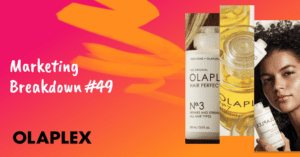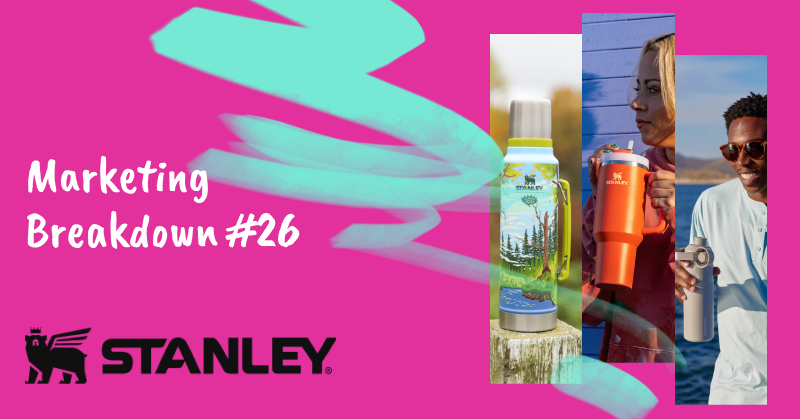
Stanley Cups: you’re either obsessed with them or you’re tired of seeing them everywhere. But did you know that this iconic brand is over 100 years old?
What’s particularly fascinating about Stanley is how they transformed a simple cup into a cultural symbol. Owning a Stanley Cup these days feels like joining a community.
In this breakdown, we’ll talk about the strategies they used to boost their revenue from $74 million in 2019 to a staggering $750 million in 2023.
Let’s jump in!
Step 1: Find the right target audience
Founded in 1913, Stanley has been a household name for generations of adventurers, handy folks, and outdoor enthusiasts.
Back in the day, Stanley primarily targeted workmen and outdoorsmen. They focused on ruggedness and utility in their marketing efforts.
Check out this archival commercial from 1978:
But things took a wild turn in recent years. Stanley shook things up by aiming their sights at a whole new target audience.
In 2016, they released the first version of the Quencher in four colors.
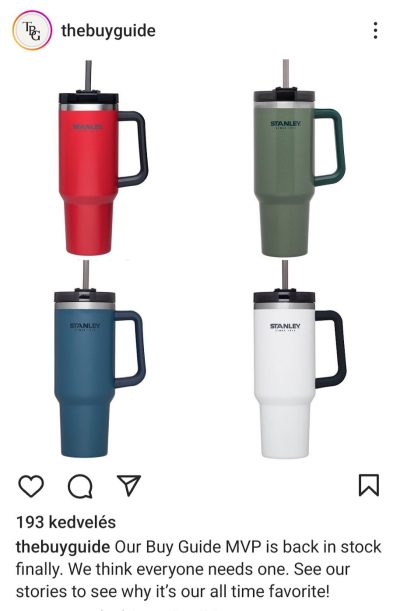
But it was a flop. They even decided to discontinue the product in 2019 due to poor performance.
Luckily, Stanley found an unexpected ally in The Buy Guide, an online shopping blog started by three moms. They were fans of the Quencher and promoted it to their readers and followers.
They also played a huge role in reshaping Stanley’s approach and spotlighting an untapped market: women.
They straight up told Stanley, “You’re marketing this cup to the wrong people.”
They emphasized the importance of creating products that connect with women’s daily lives and styles, not just their outdoor activities.
As a result, Stanley relaunched the Quencer in a brand new set of pastel colors in June 2020, which sold out within three weeks.

The lesson here is clear: don’t overlook understanding your target audience.
Whether launching something new or refreshing an old item, finding the right audience and meeting their needs is crucial.
Step 2: Collaborate with influencers and celebrities
In 2020, Terence Reilly transitioned from his role as CMO of Crocs to assume the presidency of Stanley.
At Crocs, Reilly launched collaborations with notable personalities like Post Malone and used social media to make the brand more visible.
And guess what? He brought that approach to Stanley.
One of Stanley’s earliest moves under Reilly’s leadership was the collaboration with The Buy Guide (mentioned above).
But they didn’t stop there. They started teaming up with influencers and celebrities.
They even partnered with global brands like Starbucks. This particular collaboration proved to be a hit, drawing eager crowds to Target stores. Fans lined up from the early hours of the morning just to snag a limited-edition Stanley x Starbucks tumbler.
In July 2023, Stanley introduced its first celebrity partnership.
Teaming up with country musician Lainey Wilson, Stanley launched the Watermelon Moonshine Quencher, inspired by one of Wilson’s songs.

The buzz around this launch was incredible, and the product sold out within minutes—eleven, to be exact.
Besides celebrities and big brands, lots of micro-influencers promote Stanley on social media.
And what makes Stanley’s approach to influencer partnerships particularly effective is their commitment to mutual benefits.
Stanley offers a 10% commission per sale through their affiliate program.
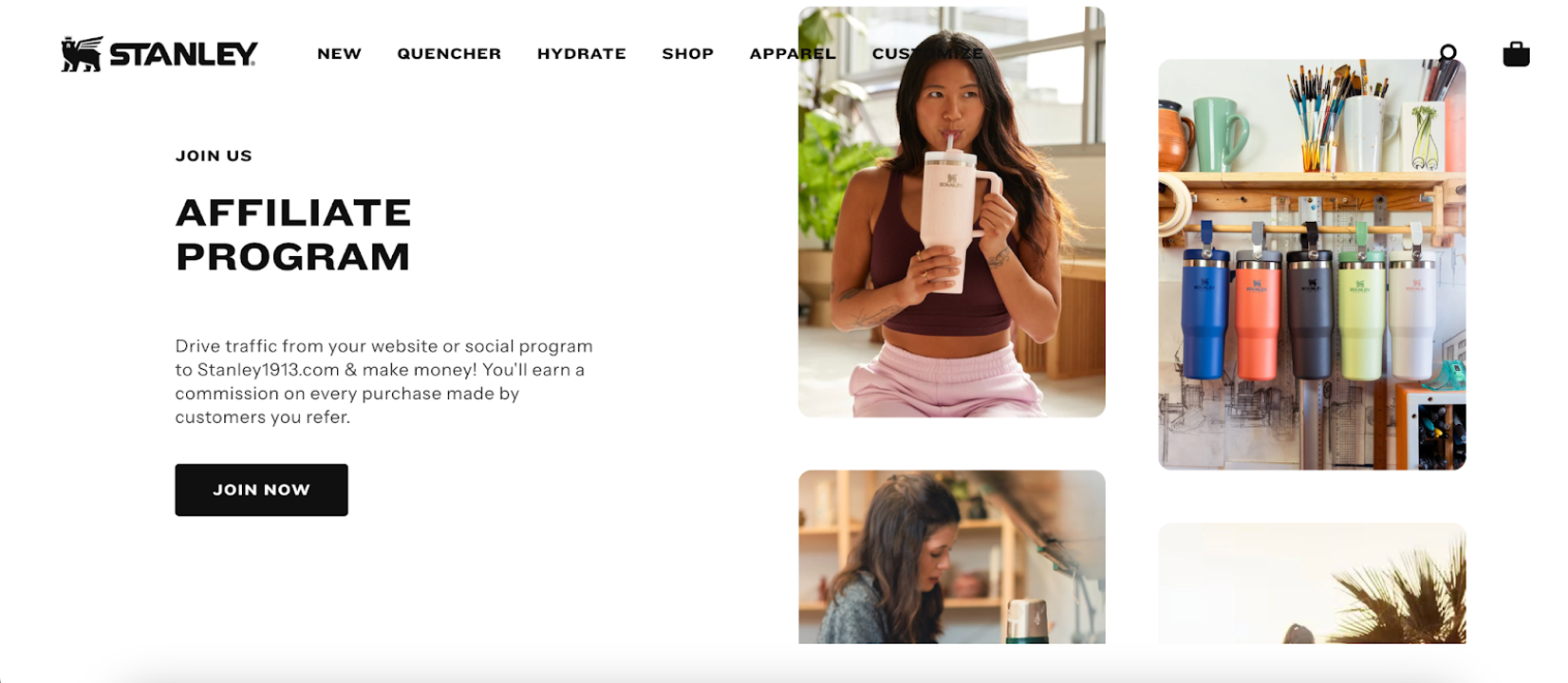
Step 3: Take advantage of user-generated content
Perhaps one of the most compelling narratives in Stanley’s marketing playbook came from an ordinary TikTok user named Danielle.
In a video that has since collected ninety-six million views, Danielle shared an insane story.
She showed her car after a fire, but guess what survived? Yup, her trusty Stanley Cup.
She picked it up and shook it, revealing the unmistakable sound of ice cubes that had remained frozen despite the flames.
Check out the viral video here:
@danimarielettering Thirsty after you catch on fire? @Stanley 1913 is like no problem i gotchu #fyp #carfire #accident #stanleycup ♬ original sound - Danielle
Recognizing the impact of this organic testament to their product’s durability, Terence Reilly took immediate action. He quickly responded and promised to restock the Stanleys and replace Danielle’s car.
This is just one example of user-generated content for Stanley.
The brand has become a staple in many “day in the life” videos across social media, with influencers casually featuring the cups as part of their everyday routines.
In an interview with GQ, pop sensation Olivia Rodrigo admitted to falling victim to this influencing, showcasing just how pervasive and influential UGC can be.
@gq Stanley Stans rise up #StanleyCup #OliviaRodrigo #Stanley #UtahSoda ♬ original sound - GQ
Stanley’s ride to fame on TikTok proves one thing: authenticity sells.
When real users share a genuine love for a product, it resonates more deeply than traditional advertising.
These moments have made Stanley a hit on social media, showing that the best content often comes from excited users.
Step 4: Increase FOMO
Creating a sense of urgency can be the golden ticket to more revenue, and Stanley has nailed this strategy.
By frequently rolling out limited editions and exclusive collaborations, Stanley is constantly creating buzz around the brand. These limited drops also create a rush of excitement among consumers, driving the products to sell out rapidly.
This strategy leverages a key cultural phenomenon: the fear of missing out, or FOMO.
Matt Navarro, senior vice president of global commerce at Stanley, explained the company’s approach to Retail Dive:
“I think there certainly is a promotional strategy around FOMO culture and really driving really intense demand for products by offering limited, special-edition drops; partnerships with other really cool, hot, trendy brands; collaborations with celebrities and artists and athletes — has really just helped create the brand status we have today.”
By frequently releasing new colors that are only available for a short time, Stanley has not just kept the market interested—they’ve turned their drinkware into a collectible phenomenon.
@justtkass I think i may have too many 😅 #stanleycup #funny #fyp ♬ original sound - South Park
This strategy cultivates a community of dedicated fans who eagerly expect each new release. These collectors not only buy the limited edition colors themselves but also become brand ambassadors, spreading the word to friends and followers and amplifying the buzz around each new drop.
This sense of exclusivity and community fosters long-term engagement with the Stanley brand.
Collectors are more likely to remain loyal customers, lusting for future releases and continuing to invest in their Stanley collection over time.
As a result, customer lifetime value is maximized. Each collector represents not just a one-time sale but a potential stream of revenue for years to come.
Step 5: Run seasonal campaigns
Seasonal marketing is a staple in the promotional playbook, and Stanley knows this.
By aligning new product releases with significant calendar events, they keep their offerings fresh and relevant, driving sales with timely connections to consumers’ lives.
Let’s check out their latest Mother’s Day campaign.
Stanley introduced a special Mother’s Day collection that caters to celebrating moms.

They highlight the seasonal campaign at the top of their homepage, guiding all visitors directly to the new collection.
They also created a dedicated section titled “Gifts for Mom” to make life easier for their visitors and help them find the right product for their moms.
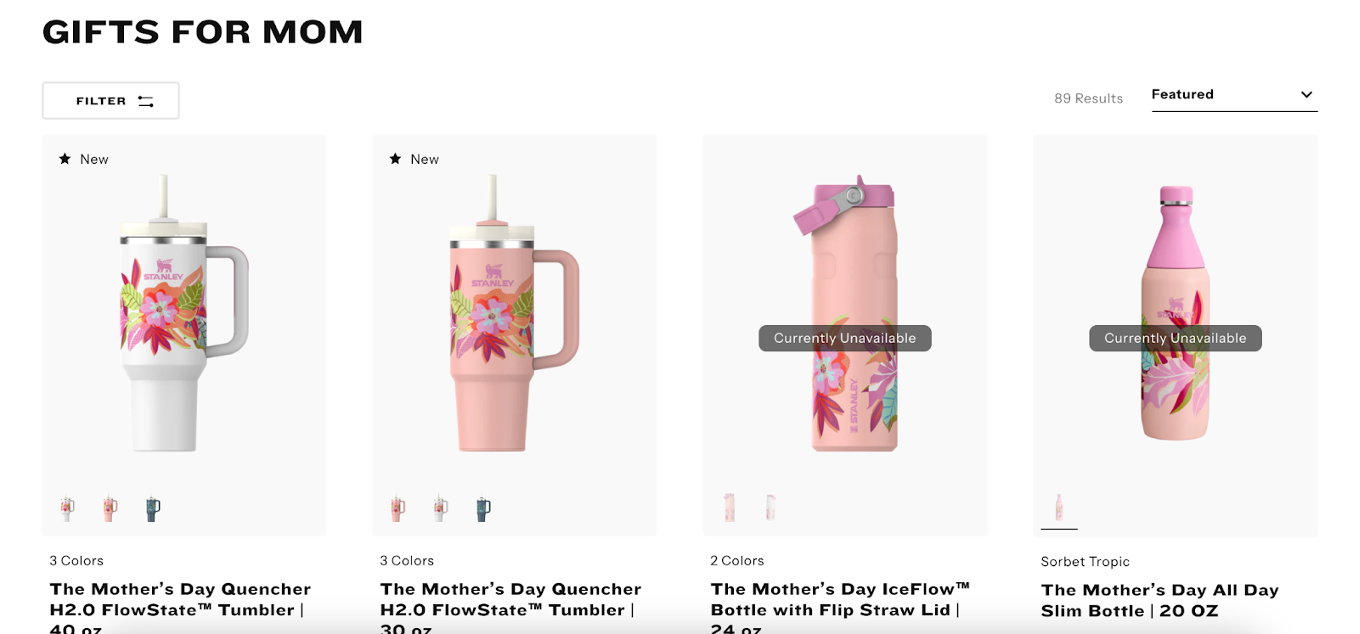
Stanley also cleverly uses social media platforms, both organically and through paid ads, to showcase these special editions. They use sweet, playful captions and engaging visuals that tug at the heartstrings.
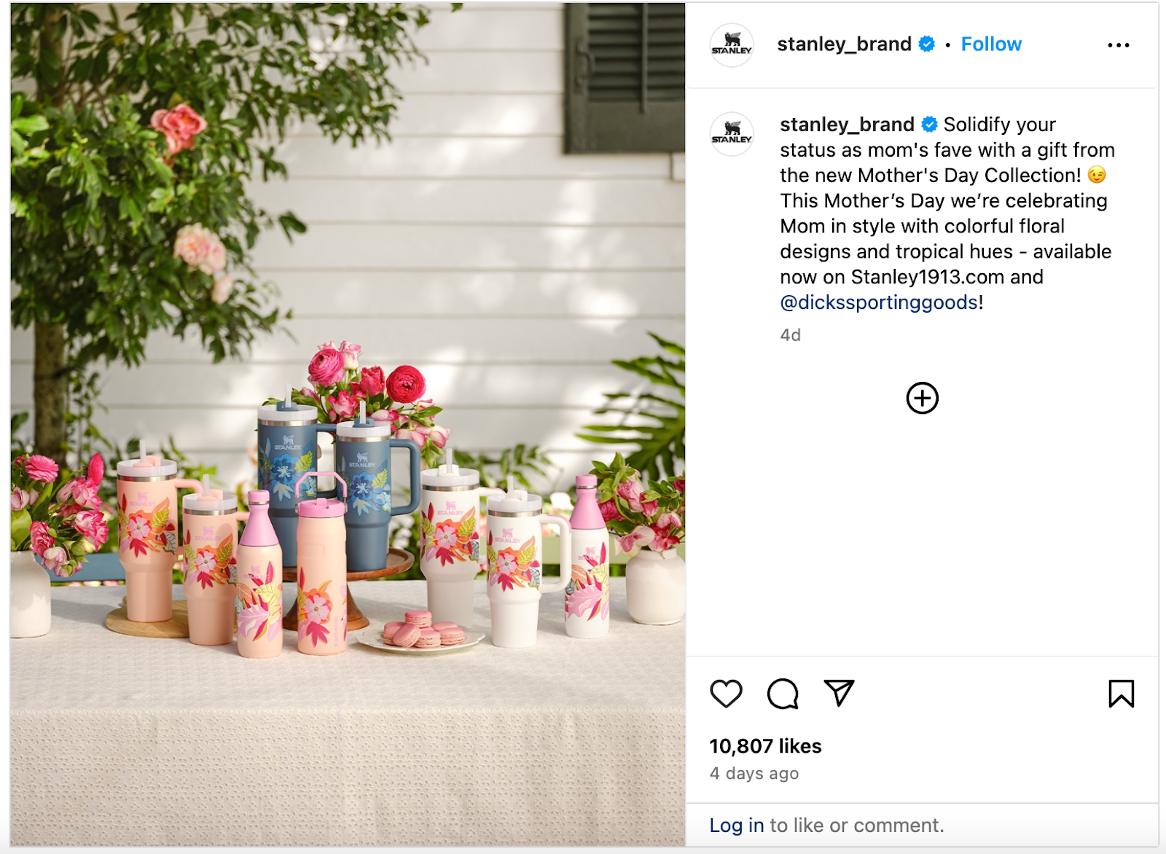

Step 6: Build your email & SMS list
Direct communication channels like email and SMS are invaluable tools for building a personal connection with consumers.
Stanley understands this and uses a two-step popup strategy that captures both the email addresses and phone numbers of new visitors.
A few seconds after a new visitor lands on the Stanley website, a popup greets them with an engaging offer: “Get 10% off your first order”.
This popup encourages visitors to subscribe to the Stanley newsletter with their email address.

This first step is crucial as it opens the door to regular email communications.
Once the user enters their email address, the popup transitions to the second step and asks for a phone number.
This move allows Stanley to extend their reach into SMS marketing. Text messages have a higher open rate compared to emails. Plus, they’re great for time-sensitive communications like flash sales, new collection drops, and last-minute deals.

By building both email and SMS lists, Stanley ensures they have multiple direct lines of communication with their customers.
And this two-step popup strategy allows them to achieve higher conversion rates than asking for both pieces of contact information in a single step.
If you’d like to use this strategy, try these popup templates:
Stanley also promotes its email and SMS subscription in the footer. This way, every website visitor can find it easily.
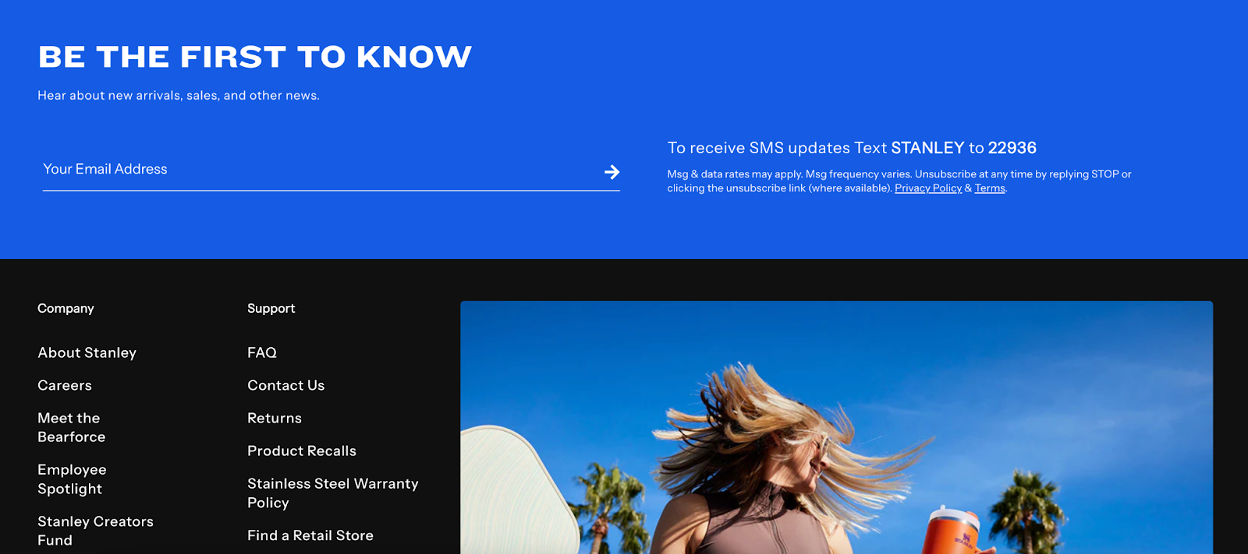
Here are some embedded content templates that will help you collect subscribers on your website:
Wrapping up
The Stanley Cups story is a classic example of how an old brand can stay relevant today and lead market trends.
Starting back in 1913 and hitting $750 million in revenue by 2023, Stanley’s journey shows how they’ve stayed in tune with what customers want and adapted over time.
Their strategy of bringing back and marketing the Quencher for women, using influencers, and capitalizing on user-generated content shows that they’re a brand that listens and responds to its audience.
Love them or hate them, there’s no denying that Stanley Cups have found the recipe for success.
Learn more
Looking for more marketing breakdowns? Check out these articles:
- AG1 Marketing Breakdown: How They Achieved a $1.2 Billion Valuation
- BÉIS Travel: Inside the Marketing Strategies that Quadrupled Sales
- Bearaby Marketing Breakdown: How to Achieve 4,999% Revenue Growth?
- Alo Yoga Marketing Strategy: How They Scaled to $247M in Revenue
- How Allbirds Went from a Small Startup to a Billion-dollar Sneaker Brand
- How Gymshark Bulked Up to Being a $1+ Billion Brand

